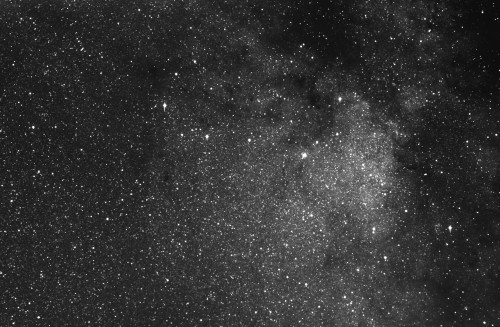For the present time we use a 80 mm photographic
objective for Messier 20 images demonstration.The objective is stopped
at f/5.6 in manner to reduce the geometrical aberrations and thus to obtain
very fine stellar images. A filter R is interposed between the objective
and camera CCD to reduce also chromatic aberrations. Audine camera is equipped
with a KAF-0401E CCD. We use of the DRIZZLE
command of Iris.

Figure 11. The figure shows one of
the 15 dithered frame obtained to test the drizzling technique with short
focal length photographic objective. The FWHM is of 1.2 pixel. Integration
time is of 60 seconds.
Figure 12. Left, the classical
average of the 15 diphered frames (simple shift and add technique). We
show here only a part of the initial image. The result is zoomed 4 time
compared to the starting format. Right, the result of the drizzling composit
algorithm (scale parameter = 4). The resolution improves is very significant
(more than 50%) !
Figure 13. It is necessary to adjust
the parameters of the diphering for an optimal result. Left, the value
of pixfrac (pixfrac=0.2) is too low what produces holes. Center, the number
n of images is too weak (n=3). Right, the parameters are nominal (pixfrac=0.6,
n=15, scale factor=4). Remenber also that the pixfrac parameter should
be slightly larger than the inverse scale factor value. For example if
the scale factor is 2, a good value for pixfrac is 0.6 (1/(scale
factor) = 0.5).
Figure 14. It is still possible
to improve the result slightly. Top left, the image at output of the diphering
processing. Top right this image was deconvolued by method of the maximum
entropy (MEM). Bottom left, we used a modified version of the Richardson-Lucy
algorithm (wavelet multiresolution regularized Richardson-Lucy restoration).
Bottom right, a scaled image, extracted from the Buil-Thouvenot Atlas,
realized with an Epsilon Takahashi 160 telescope (focal lenght of 560 mm).
The comparison with our image test made with a simple 80 mm photographic
objective is instructive. All the images are processed with QMiPS32 and
Iris softwares.

Figure 15.
Click on this image to see the result of
the diphering technique in full format (1500 X 1000 pixels). The scale
parameter scale is here equal to 2. The resolution reached is that which
one would have with a 135 millimeters objective, but the field of view
is that of an optics of 80 millimeters focal length ! This is a fundamental
property for survey programs.

Figure 16. Another example: The M11
region captured with a standard 55 mm focal length photographic lens and
with an Audine equipped with a KAF-1602E CCD (1520 X 1024 pixels). We have
combined 18 diphered individual images (180 seconds exposure each at f/5.6).
Click on the frame to display the final
result (1.2 Mb). This image has a format of 3000 X 2000 pixels and contains
a huge quantity of information (14°X 9.3° field of view).
Click here
for other examples of diphering process.















